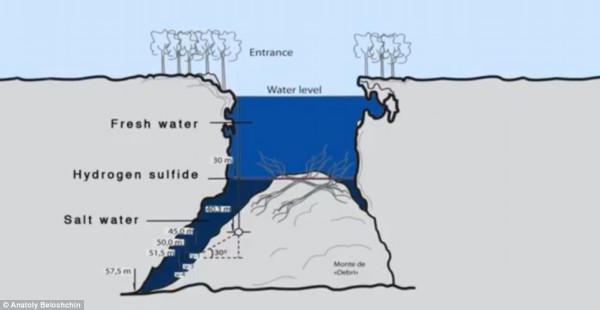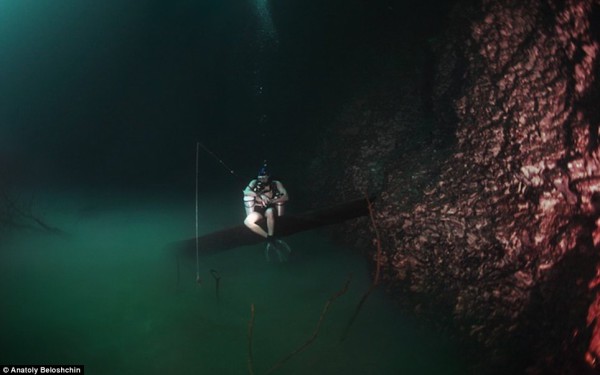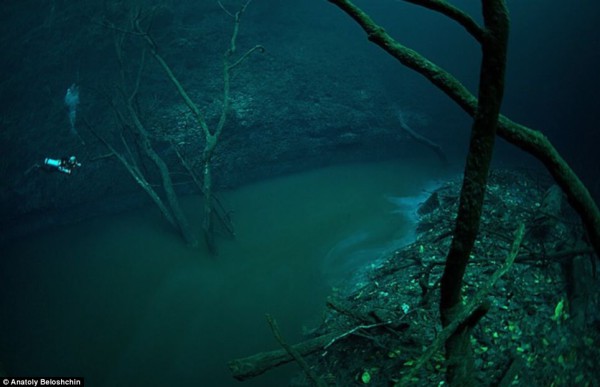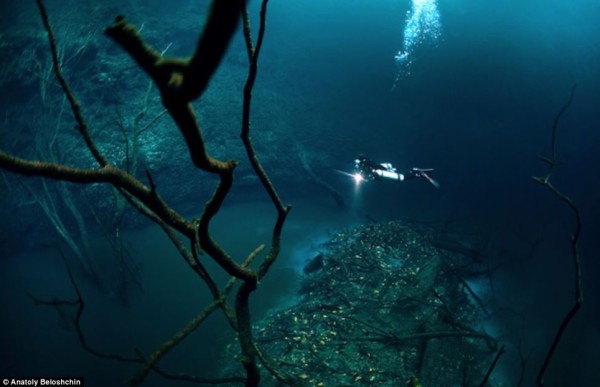Cenotes, those limpid pools that appear suddenly in the midst of thick vegetation, have astounded and mystified mankind since the dawn of time. To ancient peoples, they must have appeared as doorways to another world, and to modern man, they represent a frontier to be conquered.
What is a cenote? A cenote is nothing more than a sinkhole. They are found in any area that has limestone beds, but they are most commonly found on the Yucatan Peninsula in Mexico.
They are formed with the collapse of a limestone cave. Water seeping through limestone will, over millennia, gradually carve a cave when it finds a large enough fault. With the constant drip, drip, drip of water, the fault becomes a fissure which, over time, becomes a cave. If the weight of the rock, earth, and vegetation above the roof of the cave becomes too heavy for the limestone to support, the entire roof will collapse, exposing the water below. As this water is fresh and clean and has been filtered through the limestone, it is normally pure and crystal clear. Not all cenotes have freshwater; brackish or salty water is also found, sometimes in the same pool. These cenotes may be beautiful to look at but they are deadly to the unwary as the walls are usually precipitous and it can be a long way down from ground level to the water. Once in the water, there is no escape, unless you can climb the rock walls.
Cenotes have played an important part in the culture of the people of the Yucatan Peninsula for thousands of years. The Yucatan has no perennial water as there are few rivers, and the lakes are silted and marshy. Fresh water is available only from underground sources, so cenotes assume significant importance to the people living in the area. The Mayan people built settlements around these fresh water supplies as they needed water for domestic consumption as well as to irrigate their crops. Archaeological discoveries in the last century have shown that certain cenotes played an important part in Mayan religion and were used as the repository for sacrificial items – inanimate as well as human and animal. The discovery of items made of gold in some cenotes led expeditions to dredge the cenotes; in particular the Sacred Cenote near the Mayan settlement of Chichen Itza. Human remains were found in this cenote and were identified as having been sacrificed to the rain god, Chaac. It is clear that the Maya recognized the importance of separating the pools that were to be used for drinking water and those deemed to be sacred.

In 2002, an expedition led by Arturo Gonzalez and Carmen Sandoval discovered three human skeletons. In 2008 a different team of divers, Alex Alvarez, Franco Attolini, and Alberto Nava, were diving in the Sistema Aktun Hu of the Sistema Sac Actun (White Cave system) cenote system. Diving very deep (57 meters, or 187 feet) into the pit known as Hoyo Negro, they located a human skull and the remains of a mastodon.
One of the skeletons located in 2002 is known as Eve of Naharon; her existence has raised questions about the theories of human migration into the Americas. Eve was in her late twenties when she died and her skeleton has been carbon-dated as almost 14,000 years old. There are some questions about this carbon dating, due to the fact that the cenote contains salt water that may have affected the accuracy of the testing. The other skeletons found in the cenote date to similar periods. This discovery is important as it supports the theory that the first humans to settle in the area slowly colonized the Americas from Asia by crossing the land bridge where the Bering Strait is located today. As the Ice Age receded and the glaciers melted, this land bridge was submerged and the people were trapped in the Americas, where they continued to live and thrive.

The skeleton found at Hoyo Negro was of a teenage female, and she has been given the name Naia. Her skeleton is the oldest human remains found in this area, and DNA testing revealed she belonged to the D1 subtype, a type commonly found in modern Native Americans. This further supports the theory of migration from Asia to Beringia and the later migration of people along the coast to the lower reaches of the Americas.
The exploration of cenotes has not only led to the discovery of ancient artefacts, but they have also led to the discovery of amazing natural phenomena. One such phenomenon is found in the Cenote Angelita, “Little Angel”, in Mexico. This has become a popular dive destination for skilled and experienced divers to view the river flowing through a forest that appears ninety feet below the surface of the water. The first ninety feet of water in the cave is fresh and crystal clear; then the diver will see the most amazing sight. It appears as if there is a river, complete with trees, flowing through the cave. If the diver is brave enough to push through this phantom river, he will find himself in salt water. This river is an illusion caused by a layer of hydrogen sulphide, a couple of meters thick, which is created by the mix of fresh water and salt water. The trees are the branches that remain from the vegetation that fell into the water when the roof of the cavern collapsed. The reality is not half as magical as the idea of a tree lined river flowing through the water of a cave system!
Romantic, magical, or deadly – the cenotes of Mexico have had a marked impact on the lives of the peoples that have inhabited or visited this area for thousands of years. They are a source of fresh water, a playground, and a place of worship; they will remain all these things for many years to come.


